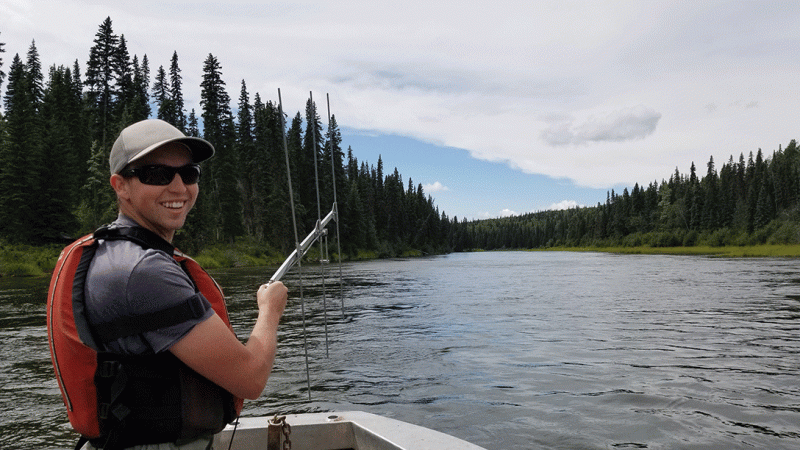Grad student explores how often river otters eat young Nechako sturgeon
River otters have been eating juvenile sturgeon released from a Vanderhoof hatchery. By visiting dozens of otter latrine sites along the Nechako River, UNBC graduate student Cale Babey has begun to quantify the extent of the predation.

Four years ago, scientists with the Nechako White Sturgeon Recovery Initiative began to suspect that river otters were eating some of the juvenile sturgeon released into the river for conservation purposes from a Vanderhoof hatchery. A new study led by a UNBC graduate student is beginning to quantify the extent of the predation.
Master of Science student Cale Babey spent the past two years tracking evidence of otter predation and presented his findings this week at the North American Sturgeon and Paddlefish Society virtual conference.
Sturgeon released from the Nechako White Sturgeon Conservation Centre in Vanderhoof are all implanted with a passive integrated transponder (PIT) tag, a small device that works like a barcode and uniquely identifies each fish.
“These PIT tags are usually used to identify fish that are captured during a juvenile sturgeon monitoring program, but they also provide a useful tool to study otter predation,” Babey explains. “When an otter eats a sturgeon, the tag is often swallowed and later defecated at specific sites otters use as latrines.”
Babey visited dozens of latrine sites along the Nechako River and used a scanning device, which Babey says is akin to a grocery store scanner, to find the PIT tags.
To date, researchers collected 1,170 juvenile sturgeon PIT tags from 59 identified latrine sites, including 524 tags collected between 2016 and 2019.
Earlier this year, researchers collected the first evidence of the predation of a wild juvenile white sturgeon. Based on the information from a PIT tag found in a latrine site, the wild fish was at least 19 years old, 69.1 centimetres long, and weighed two kilograms at the time of predation.
The largest sturgeon that exhibited evidence of otter predation was 69.8 centimetres long and weighed 2.1 kilograms at the time of release.
“These findings suggest that even larger sturgeon and wild sturgeon that have lived several years in the river are susceptible to otter predation,” Babey says.
Otter predation appears to have an impact on the conservation program for the endangered Nechako white sturgeon population. Information collected by Babey and other UNBC researchers helps inform future release strategies for the Nechako White Sturgeon Recovery Initiative and efforts to increase post-release survival.
Babey published his paper, Evidence of predation of juvenile white sturgeon (Acipenser transmontanus) by North American river otter (Lontra canadensis) in the Nechako River, British Columbia, Canada., in the Journal of Applied Ichthyology.
“Studying and understanding this predation is just one piece of the larger recovery puzzle for the Nechako white sturgeon,” Babey says.
